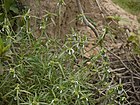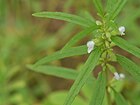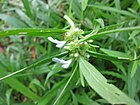Note: This is a project under development. The articles on this wiki are just being initiated and broadly incomplete. You can Help creating new pages.
Leucas aspera - Dronapushpi
Dronapushpi is a species within the Leucas genus and the Lamiaceae family. Leucas aspera is commonly found throughout India and the Philippines as well as the plains of Mauritius and Java. In India and the Philippines Leucas aspera is a very common weed.[1]
Uses
Sores of the eyes, Sores of the nose, Fever, Cough, Skin eruptions, Cold, Snakebite, Wounds, Sore throats.
Food
Leucas aspera can be used in Food. Leaves are cooked as vegetable and seeds eaten raw. Seeds also yield an oil which is used for cooking.[2]
Parts Used
Chemical Composition
Preliminary chemical examination of L aspera revealed presence of triterpenoids in entire plant. Whole plant is reported to contain oleanolic acid, ursolic acid and 3-sitosterol. Aerial parts are reported to contain nicotine, sterols.[3]
Common names
| Language | Common name |
|---|---|
| Kannada | Tumbe gida |
| Hindi | Chhota halkusa |
| Malayalam | Tumba |
| Tamil | Thumbai |
| Telugu | Tummachettu |
| Marathi | NA |
| Gujarathi | NA |
| Punjabi | NA |
| Kashmiri | NA |
| Sanskrit | |
| English | Common Leucas |
Properties
Reference: Dravya - Substance, Rasa - Taste, Guna - Qualities, Veerya - Potency, Vipaka - Post-digesion effect, Karma - Pharmacological activity, Prabhava - Therepeutics.
Dravya
Rasa
Katu (Pungent)
Guna
Ruksha (Dry), Guru (Heavy)
Veerya
Ushna (Hot)
Vipaka
Madhura (Sweet), Katu (Pungent)
Karma
Prabhava
Nutritional components
Leucas aspera Contains the Following nutritional components like - Vitamin-C; Alkaloids; Flavanoids; Terpenoids; Tannins; Saponins; Kaempferol, Glycosides; Calcium, Iron, Magnesium, Manganese, Potassium, Phosphorus, Zinc[2]
Habit
Identification
Leaf
| Kind | Shape | Feature |
|---|---|---|
| Simple | Opposite-decussate | Leaf Shape is Linear-lanceolate and Leaf Apex Acute |
Leaf Arrangement
Flower
| Type | Size | Color and composition | Stamen | More information |
|---|---|---|---|---|
| Bisexual | 2-4cm long | White with nectaries | 5 | In terminal or axillary verticils. Flowering from November-February |
Fruit
| Type | Size | Mass | Appearance | Seeds | More information |
|---|---|---|---|---|---|
| Nutlet | Erect | A subtrigonous nutlet, erect, basilar | With hooked hairs | Fruiting throughout the year |
Other features
List of Ayurvedic medicine in which the herb is used
Where to get the saplings
Mode of Propagation
How to plant/cultivate
Found wild mainly in sunny positions and in a range of soils, especially sandy and well-drained.[6]. Leucas aspera is available through July to September[2].
Commonly seen growing in areas
Photo Gallery
References
- ↑ Karnataka Aushadhiya Sasyagalu By Dr.Maagadi R Gurudeva, Page no:167
- ↑ 2.0 2.1 2.2 "Forest food for Northern region of Western Ghats" by Dr. Mandar N. Datar and Dr. Anuradha S. Upadhye, Page No.94, Published by Maharashtra Association for the Cultivation of Science (MACS) Agharkar Research Institute, Gopal Ganesh Agarkar Road, Pune
- ↑ PHYTOCHEMICAL STUDIES
- ↑ Kappatagudda - A Repertoire of Medicianal Plants of Gadag by Yashpal Kshirasagar and Sonal Vrishni, Page No. 256
- ↑ Ayurvedic preparations
- ↑ Cultivation details
External Links
- Ayurvedic Herbs known to be helpful to treat Sores of the eyes
- Ayurvedic Herbs known to be helpful to treat Sores of the nose
- Ayurvedic Herbs known to be helpful to treat Fever
- Ayurvedic Herbs known to be helpful to treat Cough
- Ayurvedic Herbs known to be helpful to treat Skin eruptions
- Ayurvedic Herbs known to be helpful to treat Cold
- Ayurvedic Herbs known to be helpful to treat Snakebite
- Ayurvedic Herbs known to be helpful to treat Wounds
- Ayurvedic Herbs known to be helpful to treat Sore throats
- Herbs with Leaves used in medicine
- Herbs with common name in Kannada
- Herbs with common name in Hindi
- Herbs with common name in Malayalam
- Herbs with common name in Tamil
- Herbs with common name in Telugu
- Herbs with common name in English
- Habit - Erect
- Index of Plants which can be propagated by Seeds
- Herbs that are commonly seen in the region of Perhumid areas
- Herbs that are commonly seen in the region of Mostly grassy plains
- Herbs that are commonly seen in the region of Arable crops
- Herbs
- Lamiaceae









